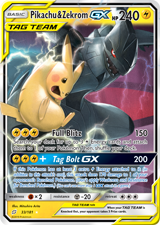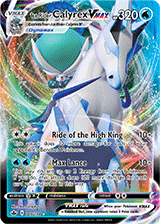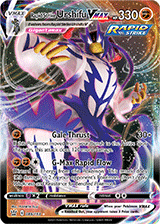Read on below to find out which Pokémon TCG cards and decks will be affected by the upcoming Pokémon TCG Standard rotation:
Check out which cards and decks will be affected by the upcoming Pokémon TCG Standard rotation.
By Robin Schulz, Contributing Writer
The yearly Standard rotation is right around the corner and will be removing all the remaining Sun & Moon Series expansions from the format. It’s a time when we have to say goodbye to some old favorites, but it’s also exciting to look forward to which decks may emerge victorious in this new environment.
Keep reading to find out about some of the key cards that are leaving, along with the implications that has on the format, before we dive deeper into a few of the decks that I think will continue to have success.
 Ever since their debut in Sun & Moon—Team Up, TAG TEAM Pokémon-GX have been at the center of competitive play. While they have been somewhat overshadowed by newer Pokémon VMAX at this point, a few of them have held up until the very end. Anyone who has been reading our pre-event Power Rankings will be familiar with Pikachu & Zekrom-GX and Arceus & Dialga & Palkia-GX. Even at the most recent Players Cup IV Global Finals, one-third of the players used decks that were centered around a TAG TEAM.
Ever since their debut in Sun & Moon—Team Up, TAG TEAM Pokémon-GX have been at the center of competitive play. While they have been somewhat overshadowed by newer Pokémon VMAX at this point, a few of them have held up until the very end. Anyone who has been reading our pre-event Power Rankings will be familiar with Pikachu & Zekrom-GX and Arceus & Dialga & Palkia-GX. Even at the most recent Players Cup IV Global Finals, one-third of the players used decks that were centered around a TAG TEAM.
Now every TAG TEAM is leaving the Standard format, and we’re moving on to Pokémon VMAX as the Pokémon that are worth 3 Prize cards when Knocked Out. I know I’m going to miss Mewtwo & Mew-GX and all the options it provided, but as with every rotation, there will be more than enough other interesting decks in the future.
The disappearance of TAG TEAM-focused decks does affect some of the popular decks that continue to exist. Eternatus VMAX, for example, always matched up rather well against them due to its damage cap being just high enough to take out a TAG TEAM in one attack. As this strength becomes less relevant, one might be more inclined to go with other options instead. Victini VMAX players, on the other hand, will be happy: Since the only Pokémon with a Rule Box remaining are Pokémon V, its Max Victory attack becomes much more reliable.
The most influential non-TAG TEAM Pokémon-GX leaving the format certainly has to be Dedenne-GX. Replacing its Dedechange Ability will not be difficult, as Crobat V‘s Dark Asset is already around and provides a very similar effect. However, it’s worth noting that a lot of decks have been playing both Pokémon and were able to use both Abilities in the same turn, while now they’ll be restricted to a single Ability per turn. For this reason, usage might go down slightly, but having access to card draw through a Quick Ball is still important, and Crobat V will continue to be a staple inclusion in almost every deck.
The previous Standard format offered two powerful ways of dealing with opposing Stadium cards that will both be gone after rotation: Marshadow and Chaotic Swell. They are frequently seen in decks that are negatively affected by certain Stadium cards, most notably Path to the Peak. Any deck that is dependent on Abilities of Rule Box Pokémon will have to look for alternatives and play their own proper Stadium cards.
Even then, not being able to turn Abilities back on with any Pokémon search card for Marshadow, or setting up preemptive protection with Chaotic Swell, will make Path to the Peak and the decks that use it more effective than they were before.
 Comeback mechanics are an important part of the game and can have a huge influence on how games are played and decks are built. Reset Stamp may not have been included in every single deck, but it was certainly a card that players always had to keep in mind.
Comeback mechanics are an important part of the game and can have a huge influence on how games are played and decks are built. Reset Stamp may not have been included in every single deck, but it was certainly a card that players always had to keep in mind.
After rotation, Marnie becomes the best form of hand disruption. One way we can take advantage of this is by including an Oranguru in our decks. With no Reset Stamp around, Oranguru can guarantee access to any card on the following turn by putting it on the top of the deck with its Primate Wisdom Ability. Even if a Marnie is played, the card will always end up in our hand next turn. Being able to plan ahead like that is a big advantage, particularly because a lot of games are decided by whether one player can draw a Boss’s Orders at the right moment.
Another very important and widely played tech card that will be lost to rotation is Mew, currently the only way to stop attacks that target Pokémon on the Bench. The most prominent such attack is Rapid Strike Urshifu VMAX‘s G-Max Rapid Flow, which has been incredibly powerful even with Mew still around, as demonstrated during Players Cup III and IV. Now that decks won’t have an easy way to stop it anymore, Urshifu VMAX will become very difficult to deal with for a lot of them.
However, there are some other Pokémon that have been held back by Mew and could not deal with it as well as Urshifu VMAX did. Inteleon VMAX, Blastoise VMAX, and Zeraora V are among cards that are heavily reliant on being able to target the Bench; now could finally be their time to shine.
Fans of alternative win conditions will need to get creative in the months ahead. Most key cards from the control-focused strategies we have seen in Players Cup III and IV, such as Excadrill and Chip-Chip Ice Axe, will be leaving the format.
Slurpuff is a potential replacement for Excadrill that can provide card retrieval; however, players will also need to come up with new strategies to replace the notorious hand-lock combo of Reset Stamp, Jessie & James, and Chip-Chip Ice Axe. It will be interesting to see whether this concept will be able to adapt.
Two of the most popular decks at the moment are Shadow Rider Calyrex VMAX and Ice Rider Calyrex VMAX. If you are playing one of them, good news—they will probably be just as good after the rotation!
 If you are looking to upgrade the Ice Rider Calyrex VMAX deck for the new format, check out Xander Pero’s recent article where he covers possible changes to the list. This deck loses very few cards to the rotation, possibly the fewest of any existing top deck. It is also one of the best decks to play Path to the Peak in, which as we’ve talked about becomes more difficult to counter.
If you are looking to upgrade the Ice Rider Calyrex VMAX deck for the new format, check out Xander Pero’s recent article where he covers possible changes to the list. This deck loses very few cards to the rotation, possibly the fewest of any existing top deck. It is also one of the best decks to play Path to the Peak in, which as we’ve talked about becomes more difficult to counter.
In addition, Zacian V, which has been one of Ice Rider Calyrex VMAX’s biggest obstacles, will need to find a new partner after Arceus & Dialga & Palkia-GX and Lucario & Melmetal-GX are gone, so it remains to be seen how well it will be able to hold up.
All this makes Ice Rider Calyrex VMAX a potential big winner of the rotation, so keep the deck on your radar as one of the top picks for the start of the format.
The other star of Sword & Shield—Chilling Reign, Shadow Rider Calyrex VMAX, will need to adapt slightly more, but I have no doubt that it will be able to maintain its position at the top equally well. Let’s look at how to modify Tord Reklev’s Shadow Rider Calyrex VMAX list from his most recent article for the new Standard format!
Post-rotation Shadow Rider Calyrex VMAX
The most notable change for the deck is Gengar & Mimikyu-GX leaving the format. The Horror House-GX attack was an incredible option that was used in almost every single game, but it’s not essential for the deck to function. It might become more difficult to get Energy into play quickly enough to take big Knock Outs with Shadow Rider Calyrex VMAX itself, but Tord’s list already includes an Alcremie VMAX line that will help with this problem.
As one of the cards to replace Gengar & Mimikyu-GX, I’ve added a Cresselia to the list. Even though we want to go first with this deck, it’s a good idea to have a strong Turn 1 play for when we need to go second. Previously, Horror House-GX was the go-to attack in that situation, but now Cresselia’s Crescent Glow appears to be the best option. Getting to attach three extra Energy on the first turn might not be as good as essentially getting a whole extra turn, but it’s pretty good nonetheless! Cresselia also greatly improves the Decidueye matchup, a deck that will surely continue to appear.
The next new inclusion to the deck is one Oranguru, for the reasons explained earlier. Another already mentioned change is swapping out Dedenne-GX for a second Crobat V.
Shadow Rider Calyrex VMAX is a Rule Box Pokémon and heavily reliant on its Ability, which means we need to be very mindful of Path to the Peak when building this deck. Even a single turn of not being able to use Underworld Door could swing a game, so we need to maximize our chances of finding Stadium cards when needed. Instead of Marshadow, which this deck will dearly miss, I’ve added another Training Court. Since playing three Stadium cards still doesn’t feel like enough, I also added a fourth one in place of a Pokémon Communication, the only Trainer card that will rotate from the original list. The second copy has been replaced by a third Evolution Incense, a card with very similar use.
And that’s all that needs to be done to make an effective post-rotation Shadow Rider Calyrex VMAX deck list! After just a few changes, this powerhouse of a deck is now ready to compete in the new Standard format.
 The last deck I want to talk about here is Alex Schemanske’s Players Cup IV-winning Rapid Strike Urshifu VMAX. As a deck focused on yet another fairly recent Pokémon VMAX, it doesn’t lose much to the rotation. Dedenne-GX, Pokémon Communication, and Reset Stamp can be swapped out for a Crobat V, two more Evolution Incense, and another Marnie. Mew doesn’t have a direct replacement, but its rotation benefits Urshifu VMAX more than it hurts.
The last deck I want to talk about here is Alex Schemanske’s Players Cup IV-winning Rapid Strike Urshifu VMAX. As a deck focused on yet another fairly recent Pokémon VMAX, it doesn’t lose much to the rotation. Dedenne-GX, Pokémon Communication, and Reset Stamp can be swapped out for a Crobat V, two more Evolution Incense, and another Marnie. Mew doesn’t have a direct replacement, but its rotation benefits Urshifu VMAX more than it hurts.
The last two missing cards, however, could end up being problematic for the deck’s future. Jirachi-GX was able to remove Urshifu VMAX’s Weakness, but after rotation, there will be no comparable effect, leaving it very vulnerable to Shadow Rider Calyrex VMAX in particular. Karate Belt enabled it to use G-Max Rapid Flow much more easily than otherwise possible, which raised the deck’s power level by quite a bit. Does that mean it won’t be as popular anymore? I don’t think so—Rapid Strike Urshifu VMAX is still too good a card to not see a lot of play, but we might see some different variations of it.
One possible approach could be combining Rapid Strike Urshifu VMAX with Galarian Moltres V. This is not new—in fact, we already saw Pedro Eugenio Torres use this concept in the Players Cup IV Global Finals! In the upcoming Standard format, there are a few additional reasons why it could be a good choice, though. In a way, Galarian Moltres V solves both the issues I just talked about. It doesn’t remove Urshifu VMAX’s Weakness, but is an alternative attacker that matches up exceptionally well against Shadow Rider Calyrex VMAX and many other Psychic-type Pokémon that Urshifu VMAX can’t deal with on its own. In addition, its Direflame Wings Ability is a way to get additional Energy into play. When combined with Energy Switch, it can be used to charge up Urshifu VMAX’s G-Max Rapid Flow in a single turn—so it can use the attack faster, just like with Karate Belt!
Sometimes it’s not possible to directly replace cards that are leaving the format. It might still be possible to find alternative strategies that serve a similar purpose, as seen in this case. A Rapid Strike Urshifu VMAX / Galarian Moltres V deck will look significantly different from Alex’s original Urshifu list, but could be how the deck evolves to keep up with the challenges of the new format.
That said, a more traditional Rapid Strike / Inteleon list will probably continue to be a fine choice as well, especially as the upcoming Sword & Shield—Evolving Skies expansion contains some formidable support for the deck in Medicham V and Raihan.
The weeks after rotation are always an exciting time. It’s a whole new format, and no one knows for sure what the best decks and lists are going to look like. Powerful Pokémon VMAX like Shadow Rider Calyrex, Ice Rider Calyrex, and Rapid Strike Urshifu look like the early favorites, but don’t forget that Sword & Shield—Evolving Skies will add even more cards to the format immediately following the rotation. There’s certainly a lot to be discovered and to look forward to! Be sure to keep checking Pokemon.com/Strategy for more Pokémon TCG coverage and analysis.
About the Writer

Robin Schulz
Robin Schulz is a contributing writer for Pokemon.com. He has been competing in Pokémon tournaments for 10 years and was the Pokémon TCG Masters Division World Champion in 2018. He spends a lot of time traveling and competing, and he rarely misses a big event. Aside from playing Pokémon, he attends university, where he is studying mathematics.
Source: Pokemon.com
Source: Pokemon


